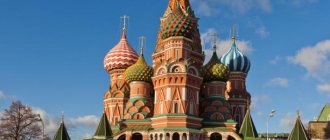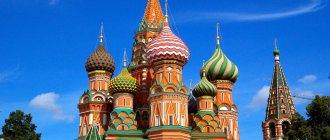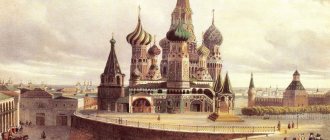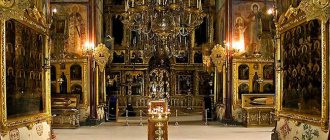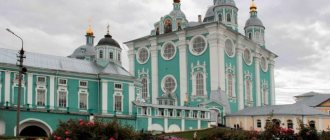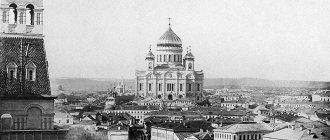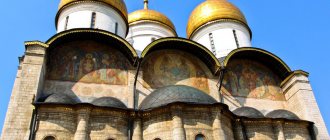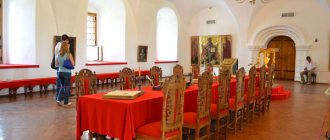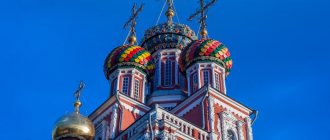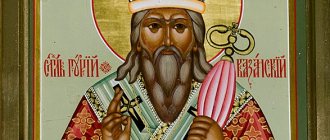A huge construction project in record time
Initially, a wooden Trinity Church stood on the site of the cathedral. Temples were erected around it during the campaigns against Kazan - they celebrated the great victories of the Russian army. When Kazan finally fell, Metropolitan Macarius suggested that Ivan the Terrible rebuild the architectural ensemble in stone. He wanted to surround the central temple with seven churches, but for the sake of symmetry the number was increased to eight. Thus, 9 independent churches and a belfry were built on one foundation; they were connected by vaulted passages. Outside, the churches were surrounded by an open gallery, which was called a walkway - it was a kind of church porch. Each temple was crowned with its own dome with a unique design and original drum decoration. The 65-meter-high structure, grandiose at the time, was built in just six years—from 1555 to 1561. Until 1600 it was the tallest building in Moscow.
Russian antiquities
Remember the scene from the beginning of Arthur Conan Doyle's story "A Scandal in Bohemia"? Or a similar episode from the first episode of the Soviet film about Sherlock Holmes “Acquaintance”? Holmes asks Watson a question: how many steps are there on the stairs leading to Baker Street? In the film, Watson answers hesitantly (eight? seven?), but in the book he doesn’t even undertake to answer - he doesn’t know. But he walked along these steps hundreds of times. The story is the same with the outstanding architectural monument, the Cathedral of the Intercession on the Moat, which turns 460 years old today. We decided to talk about this cathedral at least a little on the day of the temple’s anniversary, and then constantly update the article and publish new ones.
Everyone knows where he is - in Moscow, on Red Square (although few will name his address - Red Square, building 7). Everyone thinks they know how it works. Everyone thinks they know what it's called. However, ask anyone: “In honor of what was the main altar of that beautiful cathedral near the Kremlin consecrated?” - and in the vast majority of cases you will receive the answer: “St. Basil,” although Blessed Basil himself was canonized only 27 years after the completion of the Intercession Cathedral.
Ask: “How many domes does the cathedral have?” - and get the answer: from 4 to 12. Although in fact there are eleven of them, if you count the domes above the central tent and bell tower.
St. Basil's Cathedral, also known as the Cathedral of the Intercession on the Moat, is a wonderful example of something that everyone has seen, but few people know. The recent anniversary is a good opportunity to tell in a concise form about the most famous temple something that not everyone knows about. By the way, ask - what kind of ditch? Few will answer, although we are talking about a fortification moat near the walls of the Kremlin wall, which existed from 1508 to 1814. This ditch got its name in honor of one of the two Alevizs who worked in Moscow - Aleviz Novy, who supervised the construction of the ditch. Only after the Patriotic War of 1812 was the ditch filled in - during the reconstruction of the territory according to the design of the architect Beauvais. The remains of the ditch were excavated in the 1970s.
Alevizov ditch Reconstruction from the archive of V. A. Vinogradov.
The remains of the Alevizov ditch, uncovered in 1972-1974 during the laying of a foundation pit on both sides of the Mausoleum
Just the facts
Why is the cathedral dedicated to the Intercession of the Virgin Mary? We all remember well that the Grand Duke - at the time of the capture he was already a king and this is very important, Ivan IV, aka the Terrible (as they once wrote about him in a foreign encyclopedia: “Ioann the Terrible, nicknamed Vasilyevich for his cruelty”) took Kazan and Astrakhan took (but not Shpak). The temple was really built in memory of the Kazan campaign, and Ivan the Terrible actually promised to build a temple if luck (or rather, heavenly powers) accompanied him during the campaign.
There is an opinion that after each significant victory, wooden churches were erected on Red Square near the white-stone Trinity Church (the square itself was then called Trinity) - dedicated to the saint whose memory was celebrated on one or another day of victory. However, this tradition was started by his father, Vasily III, who, after the capture of Smolensk, erected a temple in the name of the Origin of the Holy Cross of the Lord.
Drawing by Quarenghi
When the war ended, eight wooden churches accumulated on the square. At the end of the war (and not immediately), Ivan the Terrible ordered that all churches be built in stone. True, at first a wooden Church of the Intercession was built, which was consecrated on October 1, 1554, but a year later construction of a stone temple began.
Photo by Alexey Paevsky
Perhaps eight temples would have stood like this (for example, like at Torg in Novgorod), if not for the architect (architects). Either it was the masters Barma and Postnik, or one - Ivan Yakovlevich Barma, but the solution turned out to be ingenious - to erect eight stone pillar-shaped temples on one basement (base) around the ninth - the main one. The main temple was dedicated to the Intercession - for on October 1 the walls of Kazan were blown up and the city was taken. Hence the name - Intercession on the Moat.
Recently, architectural historians have convincingly shown that the architect was, after all, of Western origin and belonged to the Western European Renaissance architectural school.
Temple in 1883. Photo from Naydenov's album
The temple was built from 1555 to 1561 using a very interesting technology. During the restoration, an important detail was revealed: before construction, a wooden frame was erected from wooden beams - 3D instructions for masons, according to which the masonry was made. Until the end of the 16th century, the Church of the Intercession was the tallest building in Moscow (in 1600 it was outgrown by the Ivan the Great Bell Tower).
Temple chronicle in the tent of the Church of the Intercession. Photo by Alexey Paevsky
The exact date of completion of the temple - June 29 (July 12, new style) was found out only in the middle of the 20th century. During the restoration of 1957-1961, researchers uncovered the temple chronicle, the text written in a circle on the transitions from the octagon to the tent and the edges of the tent itself. This is how the entry reads:
“By the grace of God and the Most Holy Theotokos, by the grace and prayers of all the saints, by the command of the pious Tsar Grand Duke Ivan Vasilyevich of All Rus', the autocrat and under his noble children under Tsarevich Ivan and under Tsarevich Theodore, with the blessing of Macarius, Metropolitan of All Rus', this holy church was completed, the Intercession of the Most Holy Theotokos in the year 7069 month of June 29 in memory of the holy and all-validated supreme apostles Peter and Paul in honor and glory of the Holy Trinity."
Walls and dome of the Intercession Church.
Photo by Alexey Paevsky Where did “St. Basil” come from? Temples were not built in an open field - Moscow in its center was already a busy place in the 16th century. Near the place where the votive churches were erected, where the construction of the Intercession Church was carried out, in the cemetery of the Trinity Church, in 1557 the revered Moscow holy fool, St. Basil the Blessed, was buried.
In 1588, by decree of Fyodor Ioannovich, a tenth temple was added to the cathedral - over the grave of the holy fool. It was in that year that St. Basil the Blessed was canonized.
St. Basil and the Intercession Cathedral. Pre-19th century image.
Later (in 1672) an eleventh altar appeared in the cathedral - in the name of another Blessed One, John. The museum's exposition now houses the chains of this saint, who bore the nickname Big Cap.
Chains of St. John the Blessed. Photo by Alexey Paevsky
So now the cathedral has 11 churches-architectural elements.
Here is their list:
- Central Church of the Intercession of the Blessed Virgin Mary
- St. Basil's Church (northeast)
- Church of Alexander Svirsky (southeast)
- Church of St. John the Blessed (southeast)
- Church of Varlaam Khutynsky (southwest)
- Church of the Entry of the Lord into Jerusalem (west)
- Church of Gregory of Armenia (northwest)
- Church of Cyprian and Justina (north)
- Church of St. Nicholas Velikoretsky (south)
- Holy Trinity Church (east)
- Church of the Three Patriarchs (northeast)
Interior of the Church of Alexander Svirsky. Photo by Alexey Paevsky
Photo by Alexey Paevsky
Speaking of domes. We do not know their original form; the images in the Facial Vault of the 1560s are very conventional. It is known for sure that the figured domes appeared after the fire of 1595 (“In the days of the pious Tsar Theodore Ioannovich, the tops of the Trinity and the Intercession on the Moat were made with rose patterns and upholstered with German iron.” Foreigners saw in them “the scales of a cedar cone, pineapple and artichoke.”
Elements of the original decor displayed in the cathedral. Photo by Alexey Paevsky
The plan and facade of the cathedral according to the drawings of Fyodor Richter of the 1850s.
The director of the museum (and, by the way, a wonderful archaeologist and specialist in encolpion crosses) Tatyana Saracheva talks about the change in the appearance of the cathedral:
“If you and I had been on Red Square in the mid-16th century, we would not have recognized the cathedral. It seemed more austere and at the same time elegant: the cathedral was painted using a fresco technique that imitates brickwork, that is, it was red and white, with colored tiles that decorated the tent of the central church. The variety of colors in the paintings and domes appeared only in the 18th century, when the cathedral was repaired with funds allocated by Catherine II. It was then that the chapters finally became colorful and recognizable throughout the world.”
Tatiana Saracheva.
Photo by Alexey Paevsky Let us add that initially it was a tented temple, surrounded by eight separate pillars. In the 17th century, a bell tower appeared at the temple, replacing the belfry, and the wooden open walkways were replaced by a covered brick gallery, painted with floral decorations, at the same time the thrones of the wooden churches demolished from Red Square were moved to the temple.
Gallery between temples. Photo by Alexey Paevsky
Basement vaults. Photo by Alexey Paevsky
At some time, the cathedral had two dozen altars - de jure independent churches (at least, this number is indicated by the inventory of dilapidations of 1688).
Element of decorative floral interior painting. Photo by Alexey Paevsky
Element of decorative floral interior painting. Photo by Alexey Paevsky
Element of decorative floral interior painting. Photo by Alexey Paevsky
Legends
There are many historical legends associated with the cathedral. The two most famous of them mention the most formidable rulers of the country. According to one of them, Ivan the Terrible ordered the architect(s) to be blinded - so that he (they) would not do anything better later. However, this did not prevent Postnik (if he built St. Basil’s) from later working on the construction of the Kazan Kremlin. This legend is already more than 300 years old - it was first voiced, it seems, by Adam Olearius about a century after the construction of the cathedral. There is also a version that after a friendly drinking session, the architect declared that he could build something even cooler, for which he was imprisoned.
They say that almost 400 years later, in 1936, Lazar Kaganovich proposed demolishing the Intercession Cathedral to make way for festive demonstrations and traffic on Red Square. They say that he ordered a model of Red Square with a removable Intercession Church and brought it to Stalin, showing how the cathedral interfered with demonstrations and cars. “And if only he - r-time!..” - and with these words he jerked the temple away from the square. Stalin looked, thought and slowly uttered the famous phrase: “Lazarus! Put it in its place!..”
Among the legends and myths associated with the temple, there is one that somewhere in the basement or in the foundation of this masterpiece is kept that same Library - the library of Ivan the Terrible. But alas: the building does not have basements or deep foundations at all, at most it is a strip foundation. The 60-meter-long colossus was built on a high basement on an artificially raised hill. There is simply nowhere to hide the library there.
The editors of the portal congratulate the cathedral and the staff of its museum on their anniversary and encourage everyone to personally get acquainted with the most famous and unknown symbol of Russia and Moscow.
Text: Alexey Paevsky
Temple in honor of the soothsayer
Although the official name of the cathedral is the Cathedral of the Intercession on the Moat, everyone knows it as St. Basil's Cathedral. According to legend, the famous Moscow miracle worker collected money for the construction of the temple, and then was buried near its walls. The holy fool St. Basil the Blessed walked the streets of Moscow barefoot, almost without clothes, almost all year, preaching mercy and help to others. There were also legends about his prophetic gift: they say he predicted the Moscow fire of 1547. The son of Ivan the Terrible, Fyodor Ioannovich, ordered the construction of a church dedicated to St. Basil the Blessed. It became part of the Intercession Cathedral. The church was the only temple that was always open - all year round, day and night. Later, by its name, parishioners began to call the cathedral St. Basil's Cathedral.
Louis Bichebois. Lithograph "St. Basil's Church"
Vitaly Grafov. Moscow wonderworker Blessed Basil. 2005
The royal treasury and lectern at Lobnoye Mesto
The cathedral has no basements. Instead, they built a common foundation - a vaulted basement without supporting pillars. They were ventilated through special narrow openings - vents. Initially, the room was used as a warehouse - the royal treasury and the valuables of some wealthy Moscow families were kept there. Later, the narrow entrance to the basement was blocked; it was found only during the restoration of the 1930s. Despite its colossal external dimensions, the Intercession Cathedral is quite small inside. Perhaps because it was originally built as a memorial monument. In winter, the cathedral was completely closed, as it was not heated. When services began to be held in the church, especially on major church holidays, very few people could fit inside. Then the lectern was moved to the Place of Execution, and the cathedral seemed to serve as a huge altar.
Russian architect or European master
It is still not known for certain who built St. Basil's Cathedral. Researchers have several options. One of them, the cathedral, was built by the ancient Russian architects Postnik Yakovlev and Ivan Barma. According to another version, Yakovlev and Barma were actually one person. The third option says that the author of the cathedral was a foreign architect. After all, the composition of St. Basil's Cathedral has no analogues in ancient Russian architecture, but prototypes of the building can be found in Western European art.
Whoever the architect was, there are sad legends about his future fate. According to them, when Ivan the Terrible saw the temple, he was struck by its beauty and ordered the architect to be blinded so that he would never repeat his majestic construction anywhere. Another legend says that the foreign builder was executed altogether - for the same reason.
Iconostasis with a turn
The iconostasis for St. Basil's Cathedral was created in 1895 according to the design of the architect Andrei Pavlinov. This is the so-called iconostasis with a turn - it is so large for a small temple that it continues on the side walls. It is decorated with ancient icons - Our Lady of Smolensk from the 16th century and the image of St. Basil, painted in the 18th century.
The temple is also decorated with paintings - they were created on the walls of the building in different years. Here St. Basil and the Mother of God are depicted; the main dome is decorated with the face of the Savior Almighty.
Iconostasis in St. Basil's Cathedral. 2016. Photo: Vladimir d'Ar
Monument to the Architects of the Kazan Kremlin. Authors: A.V. Golovacheva, V.A. Demchenko and R.M. Zabirova. 2003. Photo: livejournal.com
Why is he so colorful?
The current appearance of the Intercession Cathedral is very different from its original appearance. It had white walls, strictly painted to resemble brick. All the polychrome and floral painting of the cathedral appeared only in the 1670s. By this time, the cathedral had already undergone significant reconstruction: two large porches were added - on the north and south sides. The external gallery was also covered with vaults. Today in the decoration of the Intercession Cathedral you can see frescoes of the 16th century, tempera painting of the 17th century, monumental oil painting of the 18th-19th centuries, and rare monuments of Russian icon painting.
